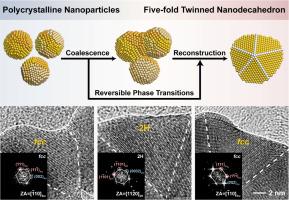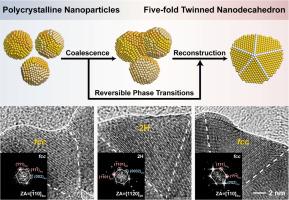五重双Au十面体无籽生长的原位透射电镜观察
IF 9.3
1区 材料科学
Q1 MATERIALS SCIENCE, MULTIDISCIPLINARY
引用次数: 0
摘要
五重双体十面体纳米粒子由于其独特的对称性而表现出非凡的性能,然而尽管大量的研究依赖于已有的双体种子或四面体构建块,但无种子形成机制仍然难以捉摸。本研究利用原位高分辨率透射电子显微镜研究了多晶金纳米颗粒在无种子状态下向五重孪晶十面体的演化过程,揭示了一种涉及可逆相变的新的多阶段生长机制。该途径通过:曲率驱动的原子扩散引发粒子颈缩;随后的局部原子重排产生相干孪晶界;双畴内可逆的fcc - 2h多型hcp-fcc相变可以通过协调的原子滑动实现晶格重建。瞬态层错是促进原子迁移的关键结构介质,显著降低了能量垒,稳定了涌现的孪晶晶格。这些发现促进了对五重孪晶金纳米结构无种子形成机理的理解,并促进了多重纳米结构的合理设计。本文章由计算机程序翻译,如有差异,请以英文原文为准。


In-situ TEM observation of the seed-free growth of five-fold twinned Au decahedra
Five-fold twinned decahedral nanoparticles exhibit exceptional properties due to their unique symmetry, yet seed-free formation mechanisms remain elusive despite extensive research relying on pre-existing twinned seeds or tetrahedral building blocks. Here, we report the seed-free evolution of polycrystalline Au nanoparticles into five-fold twinned decahedra using in-situ high-resolution transmission electron microscopy, revealing a new multi-stage growth mechanism involving reversible phase transitions. The pathway proceeds through: curvature-driven atomic diffusion initiating particle necking; subsequent localized atomic rearrangements yield coherent twin boundaries; and reversible fcc–2H-polytype hcp–fcc phase transitions within twin domains enable lattice reconstruction through coordinated atomic sliding. Transient stacking faults act as pivotal structural mediators that facilitate atomic migration, significantly reducing energy barriers and stabilizing the emergent twinned lattice. These findings advance the mechanistic understanding of seed-free formation of five-fold twinned Au nanostructures and facilitate the rational design of multiply nanoparticles.
求助全文
通过发布文献求助,成功后即可免费获取论文全文。
去求助
来源期刊

Acta Materialia
工程技术-材料科学:综合
CiteScore
16.10
自引率
8.50%
发文量
801
审稿时长
53 days
期刊介绍:
Acta Materialia serves as a platform for publishing full-length, original papers and commissioned overviews that contribute to a profound understanding of the correlation between the processing, structure, and properties of inorganic materials. The journal seeks papers with high impact potential or those that significantly propel the field forward. The scope includes the atomic and molecular arrangements, chemical and electronic structures, and microstructure of materials, focusing on their mechanical or functional behavior across all length scales, including nanostructures.
 求助内容:
求助内容: 应助结果提醒方式:
应助结果提醒方式:


